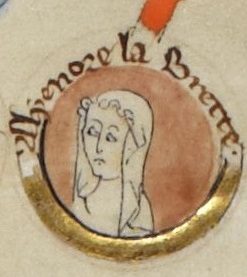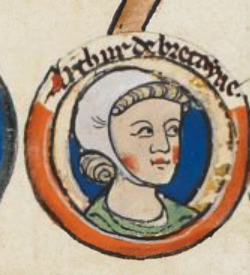On the 10th of August 1241, Eleanor Fair Maid of Brittany (House of Plantagenet) died as a nun at the age of 57 or 59. Originally buried at St James’ Priory, Bristol, her remains were then exhumed and reburied at Amesbury Abbey by King Henry III of England (her cousin), according to her wishes. The tragedy of her life truly deserves to be immortalized in a historical fiction novel.

Also called as Damsel of Brittany, Pearl of Brittany, or Beauty of Brittany, Eleanor was the eldest daughter of Geoffrey II, Duke of Brittany, the 4th son of Henry II of England and Eleanor of Aquitaine, and Constance, Duchess of Brittany. Born c. 1182-4, she lost her father at the tender age of only 2, so she was raised by her mother, Constance, as well as her uncle – King Richard I of England known as the Lionheart – and her grandmother, Eleanor of Aquitaine. Being Richard’s ward, Eleanor felt comfortable and safe during Richard’s reign. As she was in the Angevin custody, it meant that even her mother could exercise less rights for her upbringing, which belonged to Eleanor or Richard, but Constance often saw her daughter and corresponded with her.
Her younger brother, Arthur of Brittany, was the posthumous son of Geoffrey and Constance. For some time, he was the heir presumptive to England and Brittany because Richard did not have his own children in his marriage to Berengaria of Navarre. Arthur was announced heir to the whole Angevin Empire in 1190, soon after Richard’s ascension. At the time, the stunning young Eleanor was considered one of the most interesting brides in the European marriage market. While on Crusade, her uncle had an unorthodox thought of marrying his sister, Joan, off to Al-Adil I, brother of Sultan Saladin, but Joan vehemently protested. Richard then offered Eleanor as a bride, and if she had learned about that, she would have been as horrified as Joan was. But Eleanor was far away from the Holy Land! Soon Saladin’s brother lost his interest in marrying a Christian princess, and the negotiations ceased. Despite this offer, the Lionheart loved his niece and took care of her.

Everything changed for Eleanor and Arthur with the death of King Richard in 1199. Before his passing, Richard had made peace with his younger brother, John, who became the next English monarch despite the fact that Arthur’s claim to the Angevin holdings was stronger and more senior. Eleanor of Aquitaine counseled John to make peace with Arthur, but it was not meant to be. Arthur was incarcerated at the Chateau de Falaise and moved the Rouen Castle in a year. Sometime in 1203 at Rouen Castle, Arthur and John faced each other, and the king’s fiery temper flared up, leading to a serious argument while John drank wine, or perhaps he was already drunk. The legend is that John killed his nephew with his bare hands in rage, and that Arthur’s body, weighed down with stones, was thrown in the River Seine, from there it was eventually retrieved and later buried at the priory of Bec called Notre Dame de Pres. Nothing of this can be proved.
With Arthur dead, Eleanor transformed into a heiress to several vast realms, including England, Anjou, Aquitaine, and Brittany, but her ascension to any throne was not possible. Constance passed away in 1201, so she could not try to aid her daughter in some way. Maybe Eleanor could have pressed her claim to the Duchy of Brittany as her mother’s heiress, perhaps with the support of King Philippe II of France Augustus, who was gradually dismantling the Angevin Empire after Richard’s death. Yet, she could not because Eleanor was imprisoned from 1202.
King John inherited Arthur’s claim to the throne, which strengthened his position a great deal. In 1204, King Philippe II of France demanded that Eleanor, at the time confined at Corfe Castle in the Isle of Purbeck on the Dorset coast, be released to marry his younger son – Count Philippe I of Boulogne, and of course John categorically refused. In 1208, the Bishops of Nantes, Vannes, and Cornouaille attempted to negotiate Eleanor’s liberation with John, who again refused, eventually making her entrust Brittany and her county of Richmond to John. Eleanor posed a significant threat to John and his rule, and following his death in 1216, to her cousin and John’s eldest son – Henry III. Even on his deathbed, the practical John enjoined that Eleanor must never be released.


During the early reign of her cousin, Eleanor was held in gentle captivity, her conditions were slightly better, and some freedom of movement within the castles of her confinement was granted to her. Her life was guaranteed by the treaty between England and France. In 1221, the rumor circulated about the plan to smuggle Eleanor out of the country and deliver her to the ruler of France. As a result, she was transferred between Gloucester, Marlborough, and Bristol, where she finally settled from June 1224 for some time. Henry passed the law preventing Eleanor from obtaining the crown, but it did not make him sleep better, for she continued being like a dark shadow looming over him. Therefore, starting from 1223, Henry personally appointed and monitored his unfortunate cousin’s keepers, frequently changing them and making Eleanor’s life more difficult.
At the same time, contemporary sources confirm that Eleanor was treated as a royal princess despite all these restrictions. She had her own rooms at the castles where she was jailed and received gifts from the royal family such as sets of games, fruit, nuts, and wines. She wore splendid, but unrevealing, clothes. From 1225, she was granted an allowance from the state treasury, although she had nothing to spend it on as a prisoner. Henry III visited her several times, as well as Bristol’s mayor, a few bailiffs, some civilians, and trusted noblewomen, which was perhaps necessary to prove to the populace of England that Eleanor was still alive. It is recorded that once Henry sent her 50 yards of linen cloth, 50 pounds of almonds and raisins, and 3 wimples, as well as a basket of figs and another saddle, which served as evidence that she could still enjoy horse-riding. But was it really so? We don’t know an answer to this question, for Henry could have done that to showcase his magnanimity, although he does not come across as a crafty and evil monarch.
The local people of Bristol were sympathetic to Eleanor because of her well-known afflictions. She was moved again to Woodstock Manor in late1237 and then to Gloucester Castle. At last, in late 1238, Eleanor was again transferred back to Bristol Castle. She took the veil and dedicated herself to religious life. What else was left for Eleanor? According to the Chronicle of Lanercost (a northern English history covering the years from 1201 to 1346), Henry felt guilty of his cousin’s misfortunes and sent her a gold crown shortly before her death, but only several days later, this crown was gifted to his son and heir – Prince Edward (the future King Edward I). If it was really true, how ironic and callous it was of Henry to do such a thing! The same Chronicle portrayed Eleanor as the most beautiful, intelligent, well-bred, and tactful woman – a real treasure.

Eleanor of Brittany was a political prisoner. The longest-imprisoned English royal person! King John hypocritically referred to her as ‘his dearest niece’ in communicating with a group of Bretons. Her confinement was described as comfortable and honorable, although there was nothing honorable in what John and Henry both did to Eleanor. Most definitely, she did not deserve such an awful existence that deprived her of freedom, home, and children, her beauty slowly fading away within the walls of her prison. Yet, politics might be extremely cruel even to ladies. Eleanor was never tried and accused of any crime. She just had a superior claim to several realms, so she would have been dangerous for her male Plantagenet relatives if she had been released.
All images are in the public domain.
Text © 2020 Olivia Longueville





